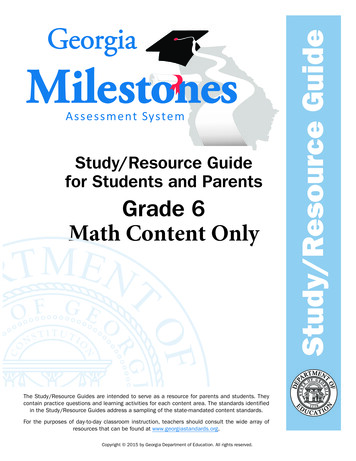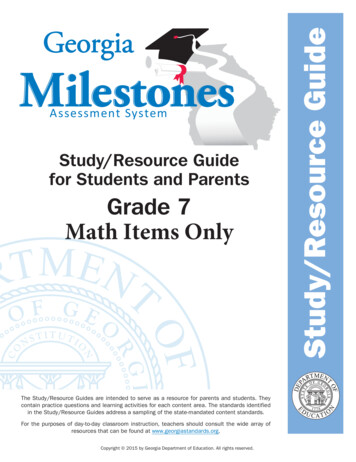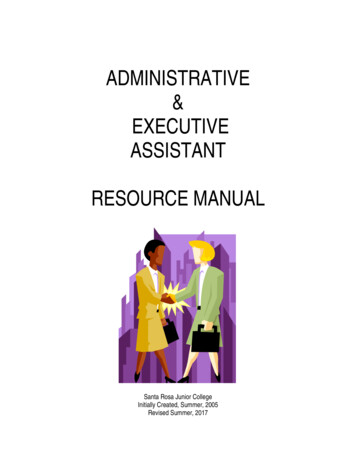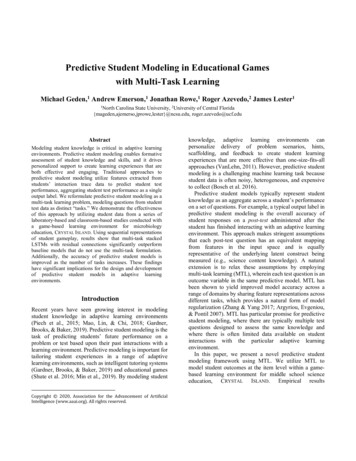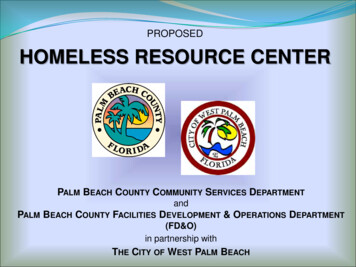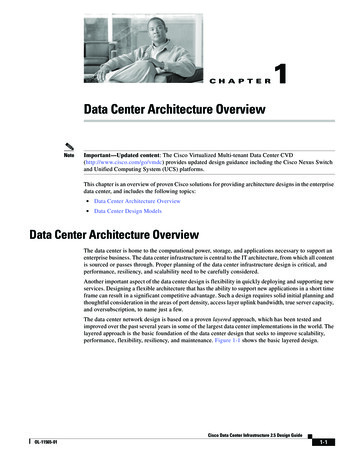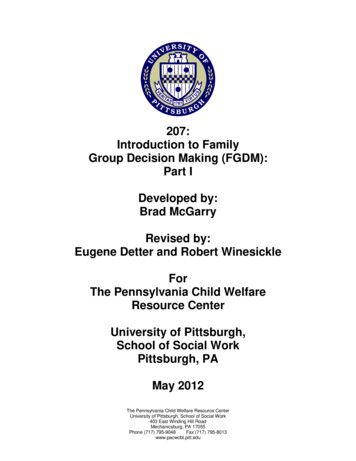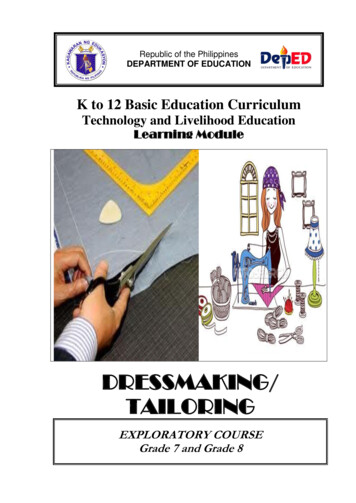
Transcription
Republic of the PhilippinesDEPARTMENT OF EDUCATIONK to 12 Basic Education CurriculumTechnology and Livelihood EducationLearning ModuleDRESSMAKING/TAILORINGEXPLORATORY COURSEGrade 7 and Grade 8
TABLE OF CONTENTSPageWhat is this Module About? . 2How do you Use this Module . 3LESSON 1 – Use of Sewing Tools. 4-22LESSON 2 – Carry Out Measurements and Calculations . 23-51LESSON 3 – Create Design for a Simple Project . 52-73LESSON 4 – Perform Basic Maintenance . 74-102LESSON 5- Practice Occupational Safety and Health . 103-123Answer Keys . 124-130Acknowledgment . 131K to 12 Basic Education CurriculumTechnology and Livelihood Education – Dressmaking/Tailoring1
What Is This Module About?Welcome to the world of Dressmaking/Tailoring!This Module is an exploratory and introductory course on Dressmaking and/or Tailoringwhich leads you to Dressmaking/Tailoring National Certificate Level II(NC II)1. Itcovers 5 common competencies in Dressmaking/Tailoring that a Grade 7/Grade 8Technology and Livelihood Education ( TLE) student like you ought to possess, namely:1) Use of sewing tools;2) Carry out measurements and calculations;3) Create design for simple project;4) Perform basic maintenance, and5) Practice occupational safety and healthThese 5 common competencies are covered separately in 5 Lessons. As shown below, eachLesson is directed to the attainment of one or more learning outcomes:Lesson 1 – Use of sewing toolsLearning Outcomes (LO) 1 Identify sewing tools and equipment and their usesLesson 2 –Carry out measurements and calculationsLearning Outcomes (LO) 1 Obtain measurementsLearning Outcomes (LO) 2 Perform simple calculationsLearning Outcomes (LO) 3 Estimate appropriate quantitiesLesson 3 –Create design for simple projectLearning Outcomes (LO) 1 Sketch simple project designLearning Outcomes (LO) 2 Produce simple projectLesson 4 –Perform basic maintenanceLearning Outcomes (LO) 1 Operate machine and assess its performanceLearning Outcomes (LO) 2 Clean and lubricate machineLesson 5 –Practice Occupational Safety and HealthLearning Outcomes (LO) 1 Identify and evaluate hazards and risksLearning Outcomes (LO) 2 Control hazards and Risks1NATIONALCERTIFICATE (NC) is a certification issued to individuals who achieved all the required units of competency for a nationalqualification as defined under the Training Regulations. NCs are aligned to specific levels within the PTQF. (TESDA Board ResolutionNo. 2004-13, Training Regulations Framework)NATIONAL CERTIFICATE LEVEL refers to the four (4) qualification levels defined in the Philippine TVET Qualifications Framework(PTQF) Where the worker in:a. NC I performs a routine and predictable tasks; has little judgment; and, works under supervision;b. NC II performs prescribe range of functions involving known routines and procedures; has limited choice and complexity offunctions, and has little accountability;K to 12 Basic Education CurriculumTechnology and Livelihood Education – Dressmaking/Tailoring2
How Do You Use This Module?This Module has 5 Lessons. Each Lesson has the following: Learning OutcomesPerformance StandardsMaterials/ResourcesDefinition of TermsWhat Do You Already Know?What Do You Need to Know?How Much Have You Learned?How Do You Apply What You Learned?How Well Did You Perform? ( Scoring Rubric )What is your Score?How Do You Extend Your Learning?ReferencesTo get the most from this Module, you need to do the following:1. Begin by reading and understanding the Learning Outcome/s and PerformanceStandards. These tell you what you should know and be able to do at the end of thisModule.2. Find out what you already know by taking the Pretest then check your answeragainst the Answer Key. If you get 99 to 100% of the items correctly, you mayproceed to the next Lesson. This means that you need not go through the Lessonbecause you already know what it is about. If you failed to get 99 to 100% correctly,go through the Lesson again and review especially those items which you failed toget.Do the required Learning Activities. They beginwith one or more InformationSheets. An Information Sheet contains important notes or basic information that youneed to know. After reading the Information Sheet, test yourself on how much youlearned by means of the Self-check. Refer to the Answer Key for correction. Do nothesitate to go back to the Information Sheet when you do not get all test itemscorrectly. This will ensure your mastery of basic information.3. It is not enough that you acquire content or information. You must be able todemonstrate what you learned by doing what the Activity / Operation /Job Sheetdirects you to do. In other words, you must be able to apply what you have learned inreal life.4. How well did you perform? Accomplish the Scoring Rubrics.Each Lesson also provides you with references and definition of key terms for your guide.They can be of great help. Use them fullyIf you have questions, don’t hesitate to ask your teacher for assistance.K to 12 Basic Education CurriculumTechnology and Livelihood Education – Dressmaking/Tailoring3
LESSON 1Use of Sewing ToolsLEARNING OUTCOMES:At the end of this Lesson, you are expected to dothe following:LO 1. Identify sewing tools and equipment are identifiedK to 12 Basic Education CurriculumTechnology and Livelihood Education – Dressmaking/Tailoring4
Definition of TermsAltering- changing portion of a garment so that it fits the body.Cutting tools- a cutting implement; a tool for cutting.Fabric- the cloth used in making garments.Measuring tools- an instruments used for obtaining quantities, dimensions or forces ofreal world objects.Sewing Machine- a textile machine used to stitch fabric, cards and other materialwith thread.Sewing Tools- instruments that aid in accomplishing a sewing taskK to 12 Basic Education CurriculumTechnology and Livelihood Education – Dressmaking/Tailoring5
LEARNING OUTCOME 1Identify sewing tools and equipment and their usesPERFORMANCE STANDARDS Sewing tools and equipment are identifiedTypes of sewing machines are classified and their uses areidentifiedMaterialsMeasuring ToolsCutting ToolsPinning ToolsMarking ToolsSewing MachinesFabricsThreadK to 12 Basic Education CurriculumTechnology and Livelihood Education – Dressmaking/Tailoring6
What Do You Already Know?Let us determine how much you already know about the use of sewing tools andequipment. Take this test.Pretest LO 1Direction: Read each item carefully and choose the letter of the best answer from thechoices below. Write your answer in your quiz notebook.1. A machine that is run by foot which may also be converted to electric power machine isknown as .a. hemmer machineb. high speed over edgerc. lockstitch machined. over edging machine2. The mechanism that sets the sewing machine in motion.a. balance wheelb. beltc. feed dogd. stitch regulator3. The part of the sewing machine that controls the looseness and tightness of Stitches.a. bobbinb. thread guidec. presser footd. upper tension4. The appropriate cutting tool used in cutting fabrics.a. Trimming shearsb. Pinking shearsc. Dressmaker bent handled shears d. buttonhole scissors5. A flexible tape with different type of measurements essential for taking bodymeasurements.a. rulerb. tape measurec. yard stickd. hem gauge6. It measures 12 -18 inches and can be used for drawing straight lines and cutting linesa. yardstickb. button hole scissorc. rulerd. French curve7. This is used to shape the depth of the neckhole and arrmhole of the pattern.a. French curveb. rulerc. tape measured. trimming scissor8. This is also called “Domestic Sewing Machine”.a. Lockstitch sewing machineb. Double needle sewing machinec. Hi-speed sewing machine d.d. Button holer machine9. A small hard pitted cup worn for protection on the finger that pushes the needlein sewing.a. thimbleb. sewing gaugec. seam ripperd. fabric10. This is used in reinforcing the opening and closing of pocketsa. Bartacking machineb. Embroidery machinec. Hi-speed locked machined. Sewing machineK to 12 Basic Education CurriculumTechnology and Livelihood Education – Dressmaking/Tailoring7
What Do You Need To Know?Read the Information Sheet 1.1 very well then find out how much you canremember and how much you learned by doing Self-check 1.1.Information Sheet 1.1Sewing Tools and EquipmentSewing equipment different tools are used ingarment construction. The skillful use of the differentsewing equipment will help take body measurement anddrafting pattern with accuracy and speed.Success in sewing calls for the right tools at theright time. All tools must be appropriate in a properorder and one must know how to use them to save timeand produce the best result.This lesson will provide knowledge and skills of the different tools and equipmentwhich are necessary in sewing. A complete set of sewing tools and equipment are presentedto help the students work faster.MEASURING TOOLSTape MeasureA flexible measuring device used in taking body measurements.The front has the measurement of 150 centimeters and 60 inches onthe other side. Fiberglass tape is commonly used by dressmakers.Sewing GaugeA small ruler with a sliding guide and is about six inches long. Thisgauge is used for measurements at hem lines, button holes and areaswhere other small measurements require checking, such as pleats andtucks. The gauge is usually made of metal or plastic.RulersA ruler measuring 12 inches or even 18 inches, either clear orsolid. It is a useful tool to have for measuring and drawing straight seamlines and cutting lines. It also aids in connecting lines. A clear ruler isalso a good tool for marking buttonholes.K to 12 Basic Education CurriculumTechnology and Livelihood Education – Dressmaking/Tailoring8
YardstickA yardstick is made of smooth, shellacked hardwood ormetal. It is used for marking hemlines and checking grainlines whenlaying out the pattern.L-squareThe tailor square or "L" is used to transfer measurements tothe draft pattern. It also divides the garment into the desiredmeasurement. It has perfect squares and is useful in making straightlines and numbers. It can also function as a tapemeasure.It has two arms connected perpendicularly.a.The longer arm is twenty-four (24) inches long.b. The shorter arm is fourteen (14) inches long.French CurveThis is used to shape the depth of the neckhole andarmhole of the pattern.CUTTING TOOLSCutting tools are instruments that serve well if properly maintained. Sharp cuttingtools make clean cuts and well-defined notches and they do not damage fabric. On the otherhand, dull tools slow the cutting process, and make your hand and wrist tire easily. Sewingcutting tools should not be used for other household task. Cutting tools must be sharpenedregularly and the joints are oiled occasionally for better use.Bent-handled dressmaker’s shearsThese are made of quality steel and hold a sharp cutting edge.The blades move easily and cut smoothly along the entire length andthe points should come together. Shears have the length of 7- 12inches and are satisfactory for most apparel fabrics.a. All steels, chrome-plated shears are for heavy duty cuttingb. Stainless steel blades and plastic handles are fine for lightweightfabricsc. A serrated edge shears give maximum cutting control andis used for synthetic fibers and slippery knitsPinking ShearsThis is popular in zigzagging or scalloped edge orfor seam finishes. This is used to finish seams and rawedges and to create decorative edges on many types offabric. It cuts a ravel-resistant edge. This is not satisfactoryK to 12 Basic Education CurriculumTechnology and Livelihood Education – Dressmaking/Tailoring9
for straight cutting.Cutting scissorsa. Trimming scissorIt is 3-4 inches long. It is used for trimmings, clipping threadsand snipping slashes.b. Embroidery scissorIt has 4-5 inches finely tapered blades. Both points are sharp foruse in working with fine details in delicate fabrics and inembroidery work.c. Buttonhole scissorThis is intended for making buttonholes.Thread ClippersThread clippers are a handy little spring loaded cutting toolthat allows for the snipping of threads. These clippers arespecifically used to snip threads and they are not designed tocut fabric.Seam RipperSeam rippers are specifically designed for rippingout stitches from seams, either as a result of an error orduring alterations. They should be used carefully to preventdamage to the fabric.Rotary Cutter and MatIt is an adaptation of the giant rotary cutter usedby the garment industry. It works like a pizza cutter andcan be used by left or right-handed sewers. The rotarycutter is available in different sizes with different blades.When using a rotary cutter, work on a cutting mat toprotect the blade and the cutting surface.K to 12 Basic Education CurriculumTechnology and Livelihood Education – Dressmaking/Tailoring10
MARKING TOOLSMarking tools are required for transferring patternmarkings to garment fabric pieces and for makingalterations on garments.Chalk Pencils/Dressmaker pencilThis is available in white or pastel shades.This chalk pencil is used to make fine lines on fabric.It has an erasing brush at one end.Liquid Marking PenLiquid marking pens come in two types. Thereis one that washes out and one that fades after 48 hours.Those that wash out should not be used on fabricthat show water marks. The mark should be removedbefore pressing the fabric.Tailor’s ChalkThis is essential as a marker for use on materials.Tailor’s chalk is available in a range of colors and isRemoved by brushing.Wax chalkThis is available in black or white and is usedfor woolen fabrics. Wax can be removed by pressing.Tracing WheelThere are two types of tracing wheels, those with a serrated edgeand those with a smooth edge. The serrated edge wheel produces dots onthe fabric and is suitable for most types of fabrics. The smooth edge wheelis best for delicate fabrics and unlike the serrated edge will not pierce moredelicate fabrics. The smooth edge wheel creates a solid line.Dressmaker’s Carbon PaperDressmaker’s carbon paper also called dressmaker’s tracingpaper is a specially waxed carbon paper that transfer’s the tracingwheel’s markings to the fabric. A color of tracing paper should bechosen that is close to the color of the fabric. Different brands ofK to 12 Basic Education CurriculumTechnology and Livelihood Education – Dressmaking/Tailoring11
tracing paper have different instructions; therefore, the instructions for the particular brandthat is purchased should be followed.PINNING AND SEWING TOOLPincushionA pincushion holds the straight pins and needles whileworking to prevent accidents.Hand NeedleUsed in making temporary stitches and buttonholes.Sizes of 7 to 10 are for general hand sewing.Sewing Needle ThreaderIt aids in putting the thread to the needle. It consists of twoparts. The handle and the wire. The end of the wire that is away fromthe holder is folded. Place the folded wire of the needle threaderthrough the eye of the sewing needle.ThimbleA small hard pitted cup worn for protection on the finger thatpushes the needle in sewing.MATERIALSFabricThe Fabric is the cloth used in making garments. The plaincotton fabrics, flour sack or catcha is the most appropriate materialfor beginners because these are very easy to handle.ThreadThe thread is used in assembling or constructing the partsof the garment. Threads vary in sizes. Heavy fabrics need strongerthreads. Threads should have the same color with that of the fabricused.K to 12 Basic Education CurriculumTechnology and Livelihood Education – Dressmaking/Tailoring12
Types of Sewing MachinesWell-selected sewing machine is essential for achieving good results. It should beused correctly in accordance with the job requirements.1. Lockstitch Sewing Machine. This is usually used in homes andsometimes in school. This is also called “Domestic Sewing Machine”.It is run by foot and may also be converted to electric powermachine.2. Hi-Speed Lockstitch Sewing Machine. This issometimes called „straight stitching machine” orindustrial sewing machine. It has automaticlubrication and is used by tailors anddressmakers.3. Over Edging Machine. Other companies call it“small machine”. It finishes the raw edges of thepattern for construction.4. Embroidery Machine. This is used in makingfancy stitches and in making different kinds ofembroidery stitches on fabrics for the BarongTagalog, pillow cases, linen, and other noveltyitems.5. Button Holer Machine. This is used inmaking buttonholes on garments.6. Button Attachment Machine. This is used inattaching buttons to the garments.K to 12 Basic Education CurriculumTechnology and Livelihood Education – Dressmaking/Tailoring13
7. Double Needle Machine. This is used in theconstruction of the different kinds of clothingespecially for the inseam, outseam and sideseam.8. Bartacking Machine. This is used inreinforcing the opening and closing of pocketsTwo Major Parts of the Lockstitch Sewing MachineThe two major parts of the lock stitch sewing machine arethe upper and lower parts.The Upper Parts is composed of:1. Head is the complete sewing machine without acabinet or stand.2. Arm is the curve part of the head containingmechanism for operating the needle.3. Bed is the flat portion of the machine and beneath isthe feed dog where it is mounted, and the shuttle andlower thread are placed.Parts of the Sewing Machine in the Arm1. Spool Pin is the thread holder.2. Thread Guide keeps the thread in position.3. Thread Take up Lever releases the thread and interlocks with the bobbin thread.4. Presser bar lifter moves the presser foot.5. Tension controls the looseness and tightness of stitches.6. Needle Bar holds the needle in place.7. Needle Clamp holds and tightens the needle.8. Presser Foot holds the fabric in place while sewing.9. Needle is a slender tool attached in the needle clamp used for sewing.10. Bobbin Winder controls the bobbin while winding thread.11. Stitch regulator checks the length of the stitches.12. Balance Wheel sets the mechanism in motion.13. Belt connects the balance wheel to the drive wheel.14. Stop Motion Screw hinders moving when loosened and startsK to 12 Basic Education CurriculumTechnology and Livelihood Education – Dressmaking/Tailoring14
Parts of Sewing Machine under the Bed1. Feed Dog moves the fabric while sewing.2. Throat plate is the windows of the feed dogand it iswhere the bobbin threads come out.4. Slide plate is a movable plate that covers theshuttleand bobbin case.4. Shuttle holds the bobbin case while sewing.5. Bobbin is a metal spool for winding thread.6. Bobbin Case holds the bobbin.K to 12 Basic Education CurriculumTechnology and Livelihood Education – Dressmaking/Tailoring15
The Lower Parts of the Lock Stitch Sewing MachineThe lower parts of the sewing machine are the cabinet and the stand. The cabinet hasdrawers and screw on the hinges for the attachment of the head.The following are the lower parts of the sewing machine and their uses:1. Band Wheel leads the balance wheel through the belt connection.2. Band Wheel Crank moves the band wheel.3. Pitman Rod holds the treadle to band wheel crank.4. Belt Guide holds the belt to its place.5. Belt Shifter removes the belt from the wheel.6. Dress Guard protects the dress from the wheel.7. Treadle is where the feet are stationed to drive the band wheel through the pitman rod.8. Legs support the cabinet of the machine.9. Cabinet holds the head of the machine by interlocking screw on the hinges.K to 12 Basic Education CurriculumTechnology and Livelihood Education – Dressmaking/Tailoring16
How Much Have You Learned?Self-Check 1.1Refer to the Answer Key. What is your score?Directions: Identify the parts of the lockstitch sewing machine. Write your answer in yourquiz notebook.K to 12 Basic Education CurriculumTechnology and Livelihood Education – Dressmaking/Tailoring17
How Do You Apply What You Have Learned?Show that you learned something by doing this activityActivity Sheet 1.1Directions:Draw the following tools in your lecture notebook.1. Measuring Tools2. Marking Tools3. Cutting Tools4. Drafting Tools5. Pinning ToolsHow Well Did You Perform?Find out by accomplishing the Scoring Rubric honestly and sincerely. Remember it isyour learning at stake!PointsCriteria10All tools were properly drawn and labeled correctly.8Almost all of the tools were properly drawn and labeled correctlySome of the items were properly drawn and labeled correctly6Most of the items were improperly drawn and labeled incorrectly.4K to 12 Basic Education CurriculumTechnology and Livelihood Education – Dressmaking/Tailoring18
Activity Sheet 1.2After learning the tools and equipment in sewing, produce a sewing kitwith the following:Create a Sewing KitA. Measuring toolsFrench curveRulerTape measureB. Cutting ToolsShearsPinking shearsScissorsRipping or thread clip scissorsTrimming ScissorsRipperC. Marking ToolsTailor ChalkPencil with eraserTracing wheelTracing PaperThreadPinsD. Drafting ToolsPattern paperMeasuring and shaping toolsE. Pinning and Sewing ToolsPinsWeightsHand NeedleThimblePin CushionHow Well Did You Perform?Find out by accomplishing the Scoring Rubric honestly and sincerely. Remember it isyour learning at stake!Points108642Criteria20-22 tools inside the sewing kit.15-19 tools inside the sewing kit.10-14 tools inside the sewing kit.5-9 tools inside the sewing kit.1-4 tools inside the sewing kit.K to 12 Basic Education CurriculumTechnology and Livelihood Education – Dressmaking/Tailoring19
Activity Sheet 1.3Objective: Identify and use sewing tools properly.Materials, Tools and EquipmentPattern PaperMeasuring toolsCutting toolsMarking toolsDrafting toolsPinning and Sewing toolsTask IProcedure:Your teacher will choose three (3) of the following tools:a. measuring toolsb. marking tools,c. cutting toolsd .drafting toolse. pinning toolsYou will be asked to identify the uses and characteristics of each tool anddemonstrate how to use them properly.Your teacher will put a check (/) in the appropriate column if you have clearlyidentified and used the tools properly.Sewing ToolsUsesCharacteristicsTools Used ProperlyA. Measuring Tools1.2.3.B. Marking Tools1.2.3.C. Cutting Tools1.2.3.D. Drafting Tools1.2.3.E. Pinning Tools1.2.3.K to 12 Basic Education CurriculumTechnology and Livelihood Education – Dressmaking/Tailoring20
How Well Did You Perform?Find out by accomplishing the Scoring Rubric honestly and sincerely. Remember it isyour learning at stake!Points108CriteriaAll tools were properly identified and used properly.Almost all of the tools were properly identified and used properlySome of the items were properly identified and used properly6Most of the items were improperly identified and used.4How Do You Extend Your Learning?Objective: Obtain sewing materials appropriate for beginners.Visit 2 or more dress shops near your place. Ask for swatchesof fabricsappropriate for beginners like you. Examine, analyzeand classify the textures and quality of different fabrics. Make a table ofcomparison and submit it to yourteacher.Put a check ( ) after each item1. Did I visit 2 or more dress shops in the place?2. Did I list down the different kinds of fabrics they areusing?3. Did I classify the different fabrics?4. Was I able to get swatches of different fabrics for samples?5. Did I make the necessary examination on the fabrics,write it down, and submit my report to my teacher?K to 12 Basic Education CurriculumTechnology and Livelihood Education – Dressmaking/TailoringYesNo21
Congratulations! You did a great job! Restand relax a while then move on to the nextlesson. Good luck!REFERENCESHilario, Carmelita B for Clothing Technology Made Easy with Lesson Plan. Valenzuela CityPhilippines. 24K Printing Co., Inc.,2001Competency- Based Learning Material, 4th YearComplete Guide to Sewing. www.sewing guide.comK to 12 Basic Education CurriculumTechnology and Livelihood Education – Dressmaking/Tailoring22
LESSON 2Carry out measurements and calculationsLEARNING OUTCOMES:At the end of this Lesson you are expected to do thefollowing:LO 1. Obtain measurements;LO 2. Perform simple calculations; andLO 3. Estimate appropriate quantities.K to 12 Basic Education CurriculumTechnology and Livelihood Education – Dressmaking/Tailoring23
Definition of TermsAccuracy – the exactness of a measured distance or circumferenceCalculation – the process or an act of calculatingCalculator – an electronic device used for speed computationConversion – a change of figures like changing from centimeters to inches and viceversaCost – the amount paid or charge for something that is acquiredEnglish System – the English system has inches for its basic unitGrain – the direction of fabric threadsHemline – the marked line at the bottom of the garment where the hem is turnedIMC – Individual Measurement ChartLength – the longer or longest dimension of an object to measureMeasurement – a systematic procedure of determining the quantity or extent of theentire measurable dimensionMetric System – a decimal system of physical units based on a unit of length known asthe meter (Greek metron, “measure”)Pattern – a piece of paper usually one-half of the body parts used as a guide in cuttingthe garmentsWidth – measurement taken at the shortest dimension of the object to measureK to 12 Basic Education CurriculumTechnology and Livelihood Education – Dressmaking/Tailoring24
LEARNING OUTCOME 1Obtain measurementsPERFORMANCE STANDARDS Parts of the body are measuredAppropriate measuring tools are selected for job.Reading of measurements is practiced with accuracy.Accurate measurements are obtained.Materials-ModelTape measureSewing gaugeRulerFrench curveK to 12 Basic Education CurriculumTechnology and Livelihood Education – Dressmaking/Tailoring25
What Do You Already Know?Let us determine how much you already know about carrying out measurementsand calculations. Take this test.Pretest LO 11.2.3.4.5.6.7.The foundation of pattern drafting is:a. Mensurationb. Measurementc. Body Partsd. English SystemThis measurement is taken from the left of the figure to the righta. Horizontal measurementb. Vertical measurementc. Circumferential measurementd. None of the aboveWhich of the following is used as a set of standard in measurementa. Metric Systemb. English Systemc. Metric and English Systemd. Tape MeasureThis kind of measurement is taken around the bodya. Verticalb. Circumferentialc. Horizontald. English systemA 60” long tape with metal tips, made of a material that will not stretcha. Yardstickb. Rulerc. Tape Measured. T-squareIt measures around the torso directly under the bustlinea. Bust to bustb. Waistc. Lower bustd. BustIt measures from under the arm. Start at the armpit to the wrist.a. Armpitb. Hipsc. Underarm d. shoulder8.Measure around the shoulder under the armpit.a. Sleeveholeb. Bustc. Waistd. torso9. The measurement is taken from the left of the figure to the righta. Verticalb. Horizontalb. Circumferentiald. Curved10. Circumferential measurement is taken around the body.a. Trueb. falsec. maybed. YesK to 12 Basic Education CurriculumTechnology and Livelihood Education – Dressmaking/Tailoring26
What Do You Need To Know?Read the Information Sheet 1.1 very well then find out how much you canremember and how much you learned by doing Self-check 1.1.Information Sheet 1.1Parts of body to be measured can be taken in: Horizontal measurement Vertical measurement Circumferential measurement1.2.3.The horizontal measurement is taken from the left of the figure to the right.The vertical measurement is taken from the top of the body figure to its base.Circumferential measurement is taken around the body.K to 12 Basic Education CurriculumTechnology and Livelihood Education – Dressmaking/Tailoring27
Neck -Loosely measure around the circumference at the base of your neck.Bust - Lift your arms to the side.Measure around your body crossing over the fullest part ofyour bust. (The tape measure must run directly over yournipples and across your shoulder blades on your back).Bust to Bust - Measure from your one nipple to your othernipple.Upper Bust - Measure around the torso directly above thebust line. From armhole to armhole - 8cm down from neck.Lower Bust - Measure around the torso directly under thebustline.Waist - Measure around the waist at the narrowest naturalwaistline point, allowing 2 fingers between your waist and tapemeasure.Hips - Measure around the fullest part of your hips. As a guide,this is often 20cm below your natural waistline. Stand with yourknees together.Shoulder to Bust - Measure from tip of the shoulder to thecentre of bust (nipple).Front Shoulder to Waist - Measure from tip of shoulder overbust to natural waistline.Shoulder to Shoulder - Measure across the back of neckfrom socket of one shoulder to socket of the other shoulder.Shoulder to Neck - Measure from base of neck along top ofshoulder to the shoulder socket.Down Center Back - Measure from nape of neck to naturalwaist.K to 12 Basic Education CurriculumTechnology and Livelihood Education – Dressmaking/Tailoring28
Back Shoulder to Waist - Measure from tip of shoulder tonatural waist line.Across Back - Measure from armhole across back to armholepositioning tape measure - 8cm down
K to 12 Basic Education Curriculum 5 Technology and Livelihood Education - Dressmaking/Tailoring Altering - changing portion of a garment so that it fits the body. Cutting tools - a cutting implement; a tool for cutting. Fabric - the cloth used in making garments. Measuring tools - an instruments used for obtaining quantities, dimensions or forces of .

